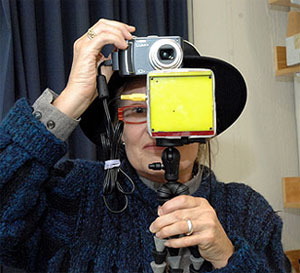CAMBRIDGE, Mass., Jan. 14, 2009 – A visually challenged MIT poet has unveiled a “seeing machine” that allows some people who are blind or visually challenged to be able to see.
Elizabeth Goldring, also an artist and a senior fellow at MIT’s Center for Advanced Visual Studies, began working on the device with fellow colleagues more than 20 years ago. What went from being a large diagnostic device costing some $100,000 to a $4,000 desktop version is now portable and inexpensive. According to Goldring, her team can produce a seeing machine for under $500.
Although the device can be connected to any visual source, such as a video camera or desktop computer, Goldring especially enjoys using it with a photo camera.

Elizabeth Goldring is shown with the camera she developed. Photo courtesy of Donna Coveney.
“When someone has a diminished sense, the inability to express yourself with that sense can be frustrating,” she said. By taking photos, “I feel I’m able to express myself visually with my blind eye, and there’s value in that, I think.
“It’s light enough that I really want to take it with me when I go for a walk.” (Goldring now has enough sight in one eye to permit mobility.)
Her idea for the seeing machine began with a visit to her optometrist. At the time, she was completely blind.
To determine whether she had any healthy retina left, technicians peered into her eyes with a scanning laser ophthalmoscope (SLO). They projected a simple image directly onto the retina of one eye, past the hemorrhages within the eye that contributed to her blindness.
She was able to see the test image. So she asked if they could write the word “sun.” “And I was amazed that I was able to read a word!” Goldring said.
She went on to use the device for other visual experiences. For example, video of her doctor was transmitted through the SLO, and for the first time she saw his face.
Even though the SLO held promise for the broader blind public, it had serious drawbacks – including its prohibitive cost. Goldring determined to develop a more practical, accessible machine.
She began collaborating with people such as Rob Webb, the SLO’s inventor and a senior scientist at Schepens Eye Research Institute, Harvard University, and with dozens of MIT students. Those involved in the current machine are Yifei Wu, an MIT senior who began the work as a freshman and has been instrumental in developing the seeing-machine camera; Brandon Taylor, a graduate student at the MIT Media Lab; and Quinn Smithwick, a postdoctoral associate in the same lab.
The portable device is relatively inexpensive, in part because it replaces the laser of the SLO with light-emitting diodes (LEDs), another source of high-intensity light that is much cheaper. 
This photo was taken with a camera Elizabeth Goldring developed that allows people who are visually impaired to take and see photos.
“Everything in it is already mass-produced for other purposes,” Taylor explained. He also noted that since the seeing-machine project began, “LCDs and other components have gotten much smaller and are readily available.”
The machine is about 5 × 5 in. and is mounted on a flexible tripod that makes it easy to carry. A digital camera is attached to the top. The visual feed from the camera travels into the seeing machine to a liquid crystal display (LCD) illuminated by LEDs. (This is the same kind of LCD common in cameras and TVs.)
The visual data is then focused into a single “point” that travels into the eye. “This is not magnification,” Smithwick said. “What makes this work is focusing the data into a tiny spot of light.”
What’s next? Goldring plans to show the new machine to other visually challenged people and looks forward to their feedback. Plans are under way to test it at the Low Vision Clinic at the Joslin Diabetes Center’s Beetham Eye Institute in Boston.
The work was supported by NASA, by MIT’s School of Architecture and Planning, Center for Advanced Visual Studies, Undergraduate Research Opportunities Program and by the Council for the Arts.
For more information, visit: www.mit.edu